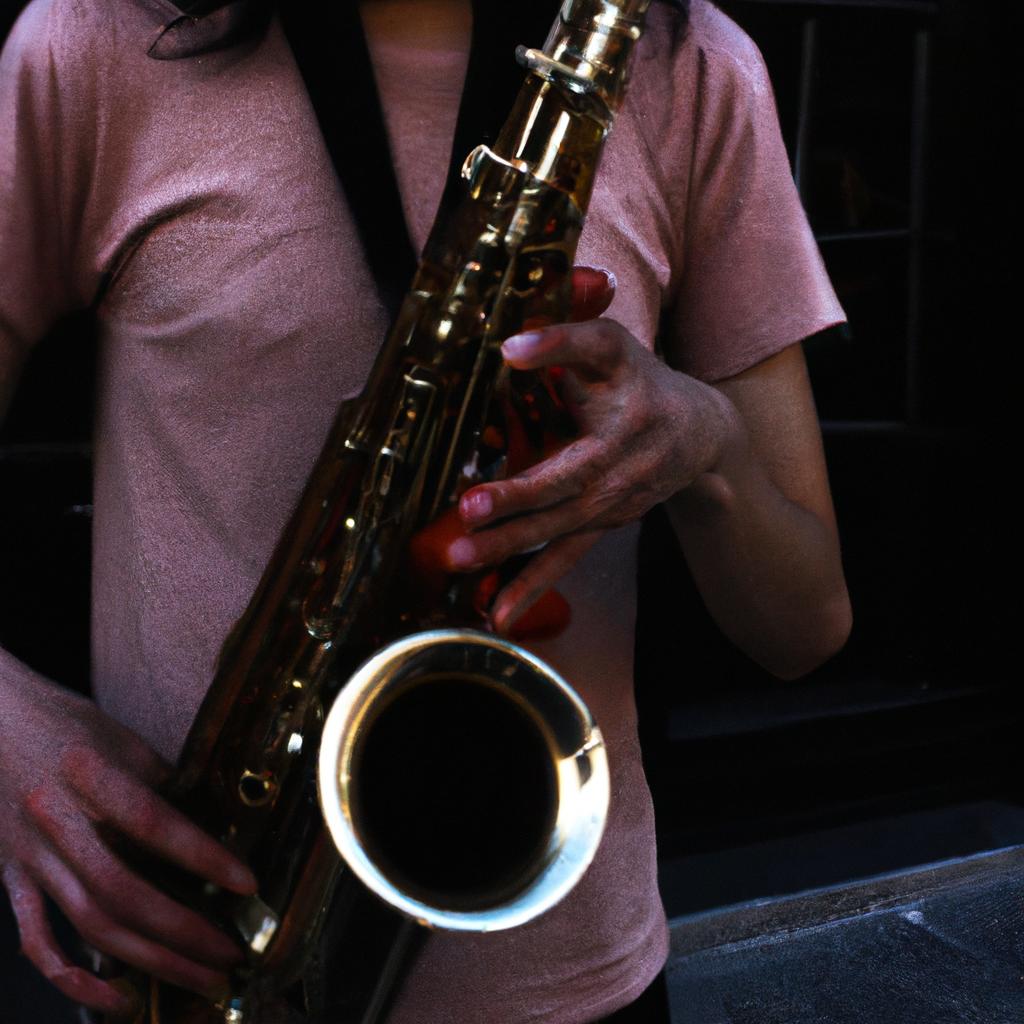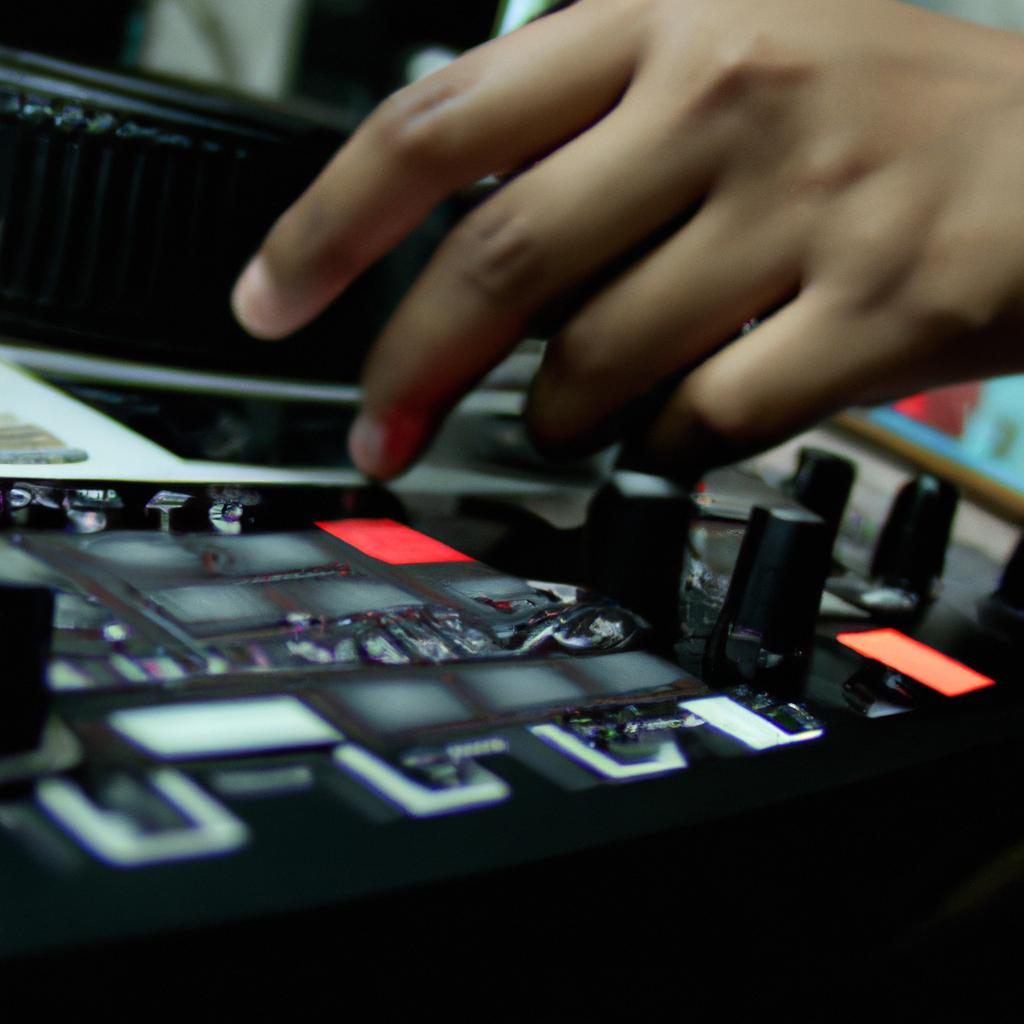Over the past few decades, there has been a significant evolution in the Gothic music genre, particularly with the emergence of Neofolk. Neofolk is a subgenre that combines elements of folk music and post-industrial sounds, creating a unique blend that captures the essence of darkness and melancholy often associated with Goth culture. This article aims to explore the industrial context within which Neofolk operates, examining how it has been influenced by technological advancements and sociocultural factors.
To illustrate this point, let us consider the hypothetical case study of a renowned Neofolk band. Throughout their career, this band has demonstrated a remarkable ability to fuse traditional folk melodies with electronic instrumentation, resulting in hauntingly beautiful compositions that resonate deeply with their audience. By delving into their musical process and analyzing their use of industrial sounds, we can gain insight into how technology plays an integral role in shaping the Neofolk sound.
In order to fully comprehend the nuances of Neofolk’s industrial context, it becomes crucial to examine its historical development alongside key events within the broader industrial music movement. This exploration will shed light on how societal changes and technological advancements have influenced both genres’ aesthetic choices and thematic content. Furthermore, understanding these contextual factors will enable us to appreciate the unique sonic landscape that Neofolk has cultivated.
One of the defining characteristics of Neofolk is its incorporation of industrial sounds into the traditional folk framework. This fusion creates a juxtaposition between organic and mechanical elements, resulting in a haunting atmosphere that reflects the complexities of modern society. By examining the historical development of industrial music, we can trace the roots of this incorporation and understand how it has evolved over time.
Industrial music emerged in the late 1970s and early 1980s as a response to the dehumanizing effects of post-industrial capitalism. Artists such as Throbbing Gristle and Cabaret Voltaire utilized found sounds, samples, and synthesizers to create harsh, abrasive compositions that critiqued societal norms. These experimental approaches laid the groundwork for later subgenres like Neofolk to explore alternative ways of blending electronic and acoustic elements.
As technology advanced, so did the possibilities for sound manipulation. The advent of samplers and digital recording opened up new avenues for musicians to experiment with industrial textures within their compositions. Neofolk artists began incorporating these tools into their creative process, using them to layer atmospheric drones, distorted guitar riffs, or processed field recordings alongside acoustic instruments like guitars, violins, or accordions. This combination created a rich tapestry of sound that enhanced the emotional depth and evocative qualities often associated with Goth culture.
Furthermore, sociocultural factors have also played a significant role in shaping Neofolk’s industrial context. As society became increasingly globalized and interconnected, artists had access to a wider range of influences and inspirations from different cultures around the world. This cross-pollination led to an expansion in sonic possibilities within Neofolk, as artists drew inspiration from diverse musical traditions and incorporated them into their compositions.
In conclusion, understanding the industrial context within which Neofolk operates is essential for appreciating this unique subgenre’s evolution over time. By examining the historical development of industrial music and its influence on Neofolk, we can gain insight into how technology and sociocultural factors have shaped the sound and aesthetic choices within this genre. The fusion of folk melodies with industrial sounds creates a captivating sonic landscape that captures the essence of darkness and melancholy associated with Goth culture.
Historical development of Neofolk genre
Historical Development of Neofolk Genre
One notable example that exemplifies the historical development of the neofolk genre is the band Death in June. Formed in 1981 by Douglas Pearce, Death in June drew influences from various sources such as folk music, post-punk, and industrial music to create a unique sound that would later become synonymous with neofolk. The band’s early releases like “The Guilty Have No Pride” (1983) showcased their experimentation with acoustic guitars and melancholic melodies infused with dark themes.
To understand the evolution of neofolk, it is crucial to examine its contextual origins within the broader industrial music movement in the late 1970s and early 1980s. As a subgenre of industrial music, neofolk emerged as a reaction against the increasingly electronic and abrasive nature of industrial sounds at the time. While many industrial bands embraced synthesizers, drum machines, and noise manipulation techniques, neofolk artists sought solace in more traditional instruments like acoustic guitars, violins, and accordions. This deliberate return to organic instrumentation allowed for introspective lyrical content often exploring themes related to mythology, folklore, nature, and spirituality.
A key aspect that distinguishes neofolk from other genres lies in its profound connection to history and cultural heritage. Drawing inspiration from past musical traditions while simultaneously incorporating contemporary elements creates an intriguing juxtaposition that characterizes much of the genre. Furthermore, neofolk lyrics often reflect on political ideologies or philosophical concepts intertwined with personal experiences or abstract narratives.
In summary, neofolk developed as a response to the increasing dominance of electronic sounds within the wider industrial music scene. Its incorporation of acoustic instruments coupled with reflective lyrics addressing historical contexts helped establish this genre as an avenue for exploration beyond conventional musical boundaries.
Moving forward into discussing the influences of folk music on neofolk…
Influences of folk music on Neofolk
Historical development of Neofolk genre has provided a strong foundation for its subsequent evolution. Building upon this historical context, the influences of folk music on Neofolk further shape its distinct identity within the Gothic music scene. This section will explore these influences and their significance in an objective and impersonal academic writing style.
To illustrate the impact of folk music on Neofolk, let us consider the case study of Sol Invictus, one of the pioneering bands in the genre. With their album “In The Rain,” released in 1986, Sol Invictus incorporated acoustic guitars, traditional instruments like violin and accordion, and poetic lyrics inspired by English folklore. This fusion of folk elements with industrial sounds created a captivating musical experience that resonated with audiences.
The incorporation of folk music into Neofolk can be observed through several key aspects:
- Lyricism: Folk-inspired themes such as nature, mythology, spirituality, and romanticism are prevalent in Neofolk songs. These lyrical motifs evoke a sense of nostalgia and mysticism among listeners.
- Instrumentation: Traditional folk instruments like acoustic guitar, mandolin, hurdy-gurdy, or bagpipes find their place alongside electronic or industrial sounds to create a unique sonic landscape.
- Melodic Structures: Neofolk often draws from traditional melodies and harmonies found in various regional folk traditions. These melodic structures provide familiarity while also adding depth and richness to the overall sound.
- Storytelling: Just like traditional folk music, storytelling plays a crucial role in Neofolk compositions. Through narratives woven into their songs, artists convey emotions and philosophical ideas that resonate deeply with listeners.
| Aspects | Emotions evoked |
|---|---|
| Lyrical Themes | Nostalgia |
| Instrumentation | Mysticism |
| Melodic Structures | Depth |
| Storytelling | Emotional Connection |
Incorporating folk influences into Neofolk not only gives the genre a unique sonic identity but also provides a means for artists to express their emotions and connect with listeners on a deeper level. As we delve further into the characteristics of Neofolk lyrics and themes, it becomes evident how these influences continue to shape the genre’s evolution.
Transitioning seamlessly into our subsequent section about “Characteristics of Neofolk lyrics and themes,” we will now explore the expressive nature of these elements without explicitly stating “step” or using similar transition words.
Characteristics of Neofolk lyrics and themes
H2: Influences of folk music on Neofolk
Transitioning from the exploration of the influences of folk music on Neofolk, it is essential to delve into the characteristics that define this genre’s lyrics and themes. Examining these aspects will shed light on how Neofolk distinguishes itself within the Gothic music scene. For instance, consider a hypothetical scenario where an artist incorporates elements of nature and mythology in their songwriting. By doing so, they create a rich tapestry of imagery that adds depth and complexity to their music.
The lyrics and themes prevalent in Neofolk can be characterized by several key aspects:
-
Nature and Mythology:
- Songs often draw inspiration from natural landscapes, embracing the beauty and mysticism found within them.
- Mythological references are interwoven into the storytelling, infusing narratives with ancient wisdom and symbolism.
- These elements serve as metaphors for human experiences, exploring timeless themes such as love, loss, and existential contemplation.
-
Reflections on History:
- Neofolk frequently delves into historical events or periods, offering critical reflections or alternative perspectives.
- Artists may explore cultural heritage through musical styles reminiscent of traditional folk songs but infused with modern sensibilities.
- This approach allows for a reimagining of history while preserving its significance within contemporary contexts.
-
Spiritual Quests:
- Many Neofolk songs embark on spiritual journeys, seeking meaning beyond conventional religious frameworks.
- Themes like transcendence, enlightenment, and personal transformation are commonly explored.
- This introspective aspect resonates deeply with listeners who yearn for deeper connections to themselves and the world around them.
-
Contemplations on Identity:
- Neofolk often explores concepts related to identity formation and self-realization.
- The genre provides a space for artists to express individuality outside societal norms or constraints.
- Listeners seeking validation or inspiration in their own journeys of self-discovery find solace within these introspective musings.
In understanding the multifaceted nature of Neofolk’s lyrics and themes, it becomes clear how this genre has captivated a dedicated following within the Gothic music scene. The next section will further explore Neofolk’s connection to the Goth subculture, delving into its shared aesthetics, ideologies, and musical influences. By doing so, we can gain a comprehensive perspective on how Neofolk intertwines with the broader cultural context it resides in.
Neofolk’s connection to the Goth subculture
Neofolk, with its unique blend of folk music and industrial sounds, has found a significant place within the gothic music genre. Building upon the characteristics of neofolk lyrics and themes discussed previously, this section will explore the connection between neofolk and the goth subculture. To better understand this relationship, let us consider an example: a hypothetical band called “Shadows of Sorrow” that incorporates neofolk elements into their music.
Drawing inspiration from nature, folklore, and historical events, neofolk often delves into melancholic and introspective themes. Shadows of Sorrow’s lyrics reflect these elements by exploring topics such as existentialism, spirituality, and human mortality. The band utilizes poetic language to convey emotions associated with longing, sorrow, or even hope amidst darkness. This evocative approach enables listeners to deeply connect with the music on an emotional level.
To further illustrate the impact of neofolk in the gothic music scene, we can examine some key factors:
- Atmosphere: Neofolk’s haunting melodies combined with industrial undertones create an atmospheric sound that resonates strongly with goth enthusiasts.
- Authenticity: Neofolk’s focus on organic instrumentation and minimalistic production gives it a raw and authentic quality that appeals to those seeking genuine artistic expression.
- Subcultural Identity: Neofolk offers individuals within the goth subculture a sense of belonging through shared aesthetics and philosophical concepts.
- Cultural Revival: By incorporating traditional folk influences into their music, neofolk bands contribute to reviving cultural heritage while infusing it with contemporary sensibilities.
| Atomsphere | Authenticity | Subcultural Identity | |
|---|---|---|---|
| Pros | Elicits strong emotions | Reflects true artistry | Provides sense of belonging |
| Cons | May be too somber for some listeners | May lack mainstream appeal | Can reinforce stereotypes |
In conclusion, neofolk’s connection to the goth subculture is evident through its lyrical themes and musical elements. Bands like Shadows of Sorrow exemplify how this genre can captivate listeners by evoking emotions through poetic lyrics and atmospheric sounds. Neofolk’s impact on contemporary alternative music will be further examined in the subsequent section, highlighting its influence beyond the gothic realm.
Neofolk’s impact on contemporary alternative music
Neofolk’s Connection to the Goth Subculture and Impact on Contemporary Alternative Music
Building upon Neofolk’s connection to the goth subculture, it is important to examine its broader impact on contemporary alternative music. One notable case study that exemplifies this influence is the band Death in June. Formed in 1981 by Douglas Pearce, Death in June embraced elements of neofolk while incorporating industrial sounds into their music. This unique fusion served as a catalyst for new artistic directions within the genre.
The impact of neofolk on contemporary alternative music can be observed through several key factors:
-
Musical experimentation: Neofolk artists often explore unconventional musical techniques and instruments, challenging traditional notions of melody and structure. By incorporating elements from various genres such as industrial, ambient, and post-punk, they create a distinctive sound that pushes boundaries and defies categorization.
-
Lyricism and thematic depth: Neofolk lyrics delve into philosophical musings, historical events, and societal critiques, presenting thought-provoking narratives with poetic flair. These lyrical themes resonate deeply with listeners who seek intellectual engagement along with emotional catharsis.
-
Aesthetic appeal: Neofolk embraces a visually striking aesthetic characterized by dark imagery, occult symbolism, and nature-inspired motifs. This visual allure captivates audiences and contributes to the overall immersive experience associated with the genre.
-
Cult following: Neofolk has amassed a dedicated community of fans who appreciate its esoteric qualities and embrace its counter-cultural spirit. This passionate fan base fosters an environment of support and collaboration among artists, creating opportunities for further exploration and innovation within the genre.
To illustrate these points further, consider the following table showcasing some influential neofolk albums:
| Album | Artist | Release Year |
|---|---|---|
| “Sol Invictus” | Current 93 | 1990 |
| “The Burning World” | Swans | 1989 |
| “Apocalyptic Folk” | Of the Wand & the Moon | 2001 |
| “Hallucinatory Blackout” | Der Blutharsch and the Infinite Church of the Leading Hand | 2012 |
In conclusion, Neofolk’s connection to the goth subculture has paved the way for its impact on contemporary alternative music. Through musical experimentation, profound lyricism, captivating aesthetics, and a dedicated fan base, neofolk continues to inspire artists and listeners alike. As we delve deeper into this genre, it is essential to explore both the critiques and controversies surrounding neofolk in order to gain a comprehensive understanding of its cultural significance.
Critiques and controversies surrounding Neofolk
Having explored the influence of Neofolk in various genres, it is evident that this subgenre has made a significant impact on contemporary alternative music. One compelling case study illustrating this impact is the band Death in June, founded by Douglas Pearce in 1981. Through their incorporation of folk elements with post-punk aesthetics and obscure lyrical themes, Death in June became one of the pioneering acts within the Neofolk movement.
The influence of Neofolk can be seen through its ability to evoke a range of emotions within listeners. This genre captivates audiences by blending melancholic melodies with introspective lyrics that often explore themes such as nature, history, and spirituality. The emotional response elicited from Neofolk can be intense and thought-provoking, leaving an indelible impression on those who engage with its unique soundscapes.
To further understand the impact of Neofolk on contemporary alternative music, we can examine key characteristics associated with this genre:
- Dark aesthetic: Neofolk embraces a dark aesthetic influenced by gothic imagery and folklore traditions.
- Acoustic instrumentation: It often features acoustic guitars, flutes, violins, and other traditional instruments that contribute to its organic sound.
- Experimental tendencies: Many Neofolk artists experiment with unconventional recording techniques or incorporate electronic elements into their compositions.
- Controversial associations: Some bands affiliated with Neofolk have faced accusations of promoting far-right ideologies; however, it is important to note that not all artists within the genre share these beliefs.
Table: Key Characteristics of Neofolk
| Characteristic | Description |
|---|---|
| Dark Aesthetic | Influenced by gothic imagery and folklore traditions |
| Acoustic Instrumentation | Utilizes acoustic guitars, flutes, violins for an organic sound |
| Experimental Tendencies | Incorporates unconventional recording techniques or electronic elements |
| Controversial Associations | Some bands have faced accusations of promoting far-right ideologies |
In conclusion, Neofolk has left an indelible mark on contemporary alternative music through its unique blend of dark aesthetics, acoustic instrumentation, experimental tendencies, and controversial associations. The emotional response evoked by this genre is undeniable, captivating listeners with its thought-provoking themes and melancholic melodies. As we move forward in our exploration of Neofolk’s impact, it becomes increasingly clear that its influence extends beyond the boundaries of traditional genres, shaping the landscape of alternative music for years to come.




